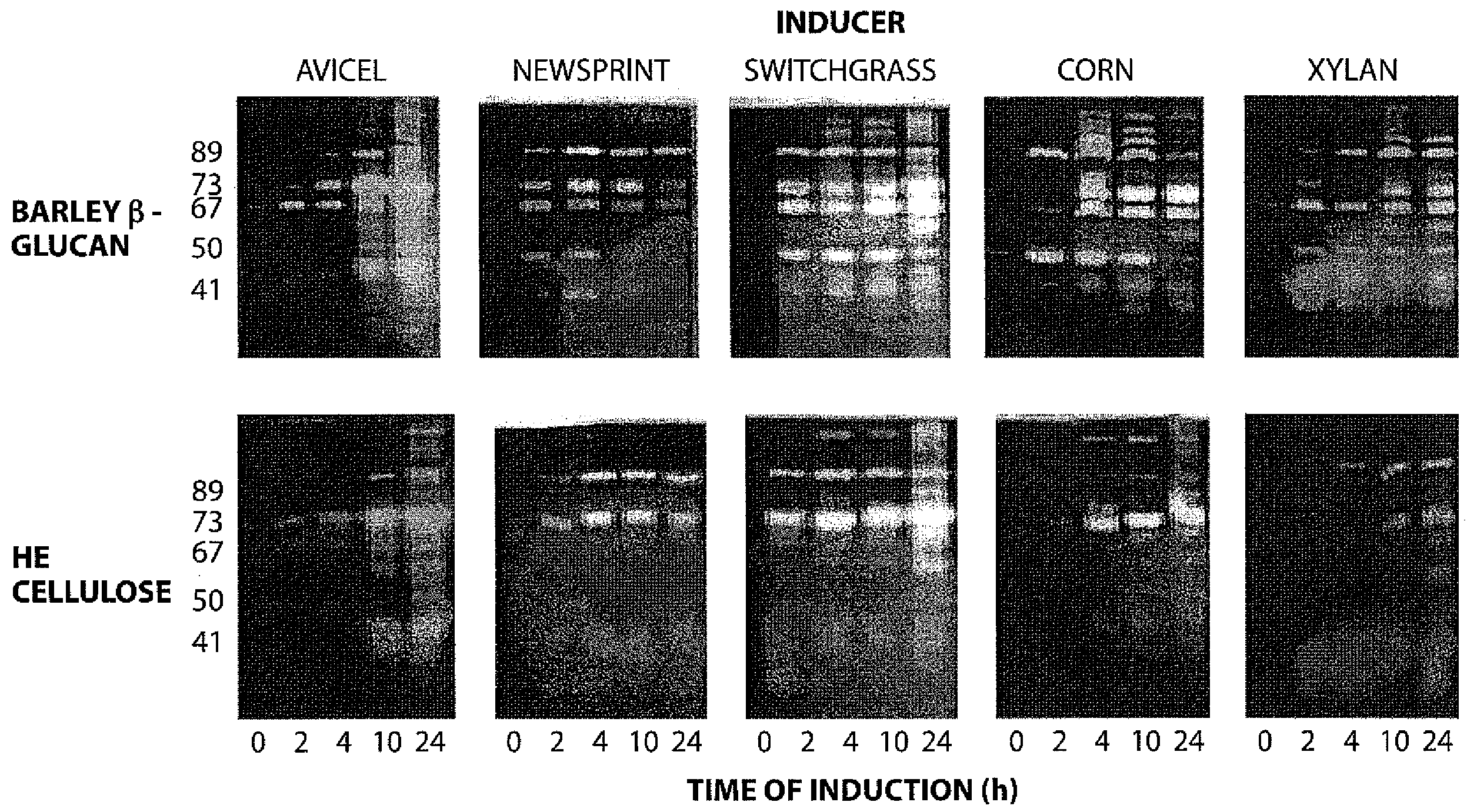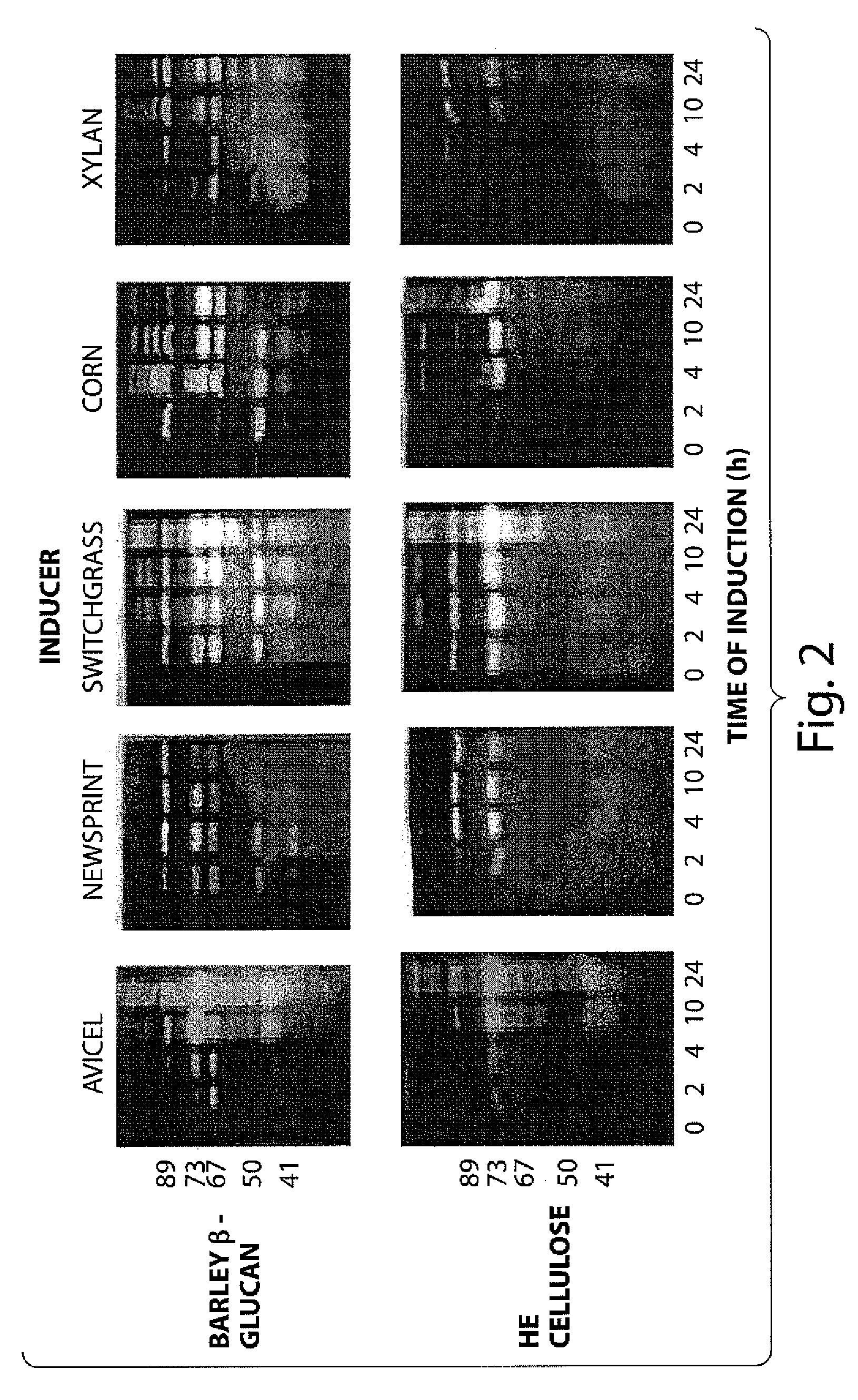Carbohydrase expression during degradation of whole plant material by saccharophagus degradans
a technology of saccharophagus and carbohydrase, which is applied in the field of carbohydrase expression during degradation of whole plant material by saccharophagus degradans, can solve problems such as difficulty in breaking down
- Summary
- Abstract
- Description
- Claims
- Application Information
AI Technical Summary
Benefits of technology
Problems solved by technology
Method used
Image
Examples
example 1
Genotyping Methods
[0049]The growth rate of S. degradans was cultured on different substrates (FIG. 1). The basic media was composed of (2.3% Instant Ocean, 0.05% Yeast Extract, 0.05% NH4Cl, 15 mM Tris, pH 6.8). The final concentration of each carbon source were 0.2% for Glucose, Xylose, Cellobiose, Arabinose, Xylan, Avicel and 1.0% for Newsprint, Switchgrass, and corn leaves. S. degradans grew on all plant material it was grown on.
[0050]A Zymogram was performed to find which glucanases were induced during growth on various cell wall polymers (FIG. 2). Cells were grown to an OD600 of 0.3-0.5 in media containing glucose as the sole carbon source, harvested and transferred to the same volume of media containing the indicated inducer. Samples were removed at the indicated times and proteins in samples normalized to OD600 were fractionated by standard SDS-PAGE in which either 0.1% barley α-glucan or HE cellulose was included in the resolving gel. Gels were incubated in refolding buffer (...
example 2
Measurement of Increase in Expression of Xyn10A, Xyn10B, Xyn11A and Xyn11B in Response to Growth of S. degradans on Xylan
[0052]Primers were designed for six target genes: xyn10A-D and xyn11A-B along with two house keeping genes: dihydrofolate reductase and guanylate kinase. S. degradans was cultured in glucose media until OD600 reached 0.370-0.400. The 0 hour time point was taken and the cultures were transferred to xylan media for 10 hour time course experiments. A second culture was transferred back to glucose as a control. Samples were taken at 0, 2, 4 and 10 hours from both the xylan and glucose cultures.
[0053]RNA from each sample was purified using RNAprotect™ bacteria reagent (Qiagen) and Rneasy MiniKit. The isolated mRNA was transformed using QuantiTech™ reverse transcriptase and expression patterns were analyzed using LightCycler Pro™ pRT-PCR.
[0054]As shown in FIG. 6, xyn10A, xyn10B, xyn10D, xyn11A and xyn11B all had greater mRNA expression at 2, 4, and 10 hours after exposu...
PUM
| Property | Measurement | Unit |
|---|---|---|
| volume | aaaaa | aaaaa |
| pH | aaaaa | aaaaa |
| pH | aaaaa | aaaaa |
Abstract
Description
Claims
Application Information
 Login to View More
Login to View More - R&D
- Intellectual Property
- Life Sciences
- Materials
- Tech Scout
- Unparalleled Data Quality
- Higher Quality Content
- 60% Fewer Hallucinations
Browse by: Latest US Patents, China's latest patents, Technical Efficacy Thesaurus, Application Domain, Technology Topic, Popular Technical Reports.
© 2025 PatSnap. All rights reserved.Legal|Privacy policy|Modern Slavery Act Transparency Statement|Sitemap|About US| Contact US: help@patsnap.com



